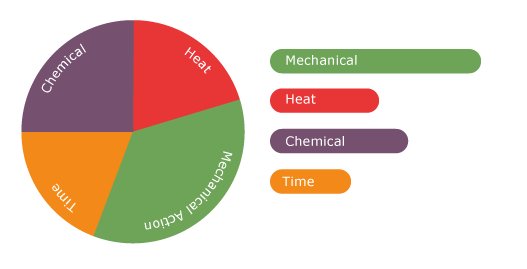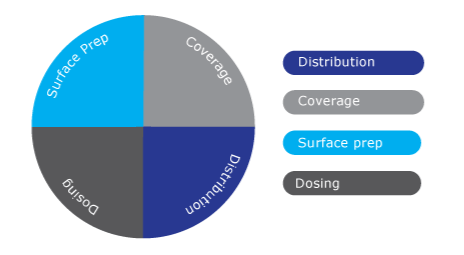Levels of cleaning
When sourcing the correct spray solution the first question is what level of cleaning needs to be achieved. Cleaning can be roughly categorised into 5 levels :-
Sterilising - The removal of residue by either washing or rinsing and the additional application of chemicals and/or heat that will kill all life.
Disinfecting - The removal of residue by either washing or rinsing and the additional application of chemicals and/or heat that will kill 100% of bacteria but not necessarily spores.
Sanitising - The removal of residue by either washing or rinsing and the addition of a sanitising chemical that kills or removes contaminants or pathogens to an acceptable level.
Washing - The removal of residue by a combination of dissolving in cleaning fluid and action of direct pressure.
Rinsing -The removal of most or all of residue by dissolving in cleaning fluid alone.
After the level of required cleaning is determined consideration can be given to the impact, volume and time of spray that will be required to achieve this.
Cleaning vs disinfection/steralising
Broadly speaking the above 5 levels can be broken down into two distinct processes. The cleaning process involves the removal of residues and some pathogens to an acceptable level. Cleaning, therefore, takes us up to the sanitising level of cleanliness and no more. This can be achieved with the standard cleaning systems that rely on the four core elements of cleaning as outlined in the sinner circle.  Namely:
Namely:
- Time
- Heat
- Mechanical action
- Chemical action
The effectiveness of any cleaning operation is made up of the sum of these component elements. If we reduce one we must increase another in order for the cleaning process to remain effective. Optimising cleaning systems often involves trading off less cost elements against more costly ones. For example it is often the case that improved nozzles will increase mechanical action for relatively little cost allowing the more costly elements of heat and/or time to be reduced and thus a more efficient clean is achieved.
If we want to move beyond the sanitising level of cleaning and achieve disinfection or complete sterilisation then often different fluid delivery systems are required. In these processes there are again four key elements to consider.
 Distribution – how well distributed the biocide is over areas being treated. Often good distribution over a large and complex area is only achievable by fogging systems.
Distribution – how well distributed the biocide is over areas being treated. Often good distribution over a large and complex area is only achievable by fogging systems.
Coverage – how well covered with biocide are the surfaces being treated. Even small gaps means pathogens can survive but over-usage of expensive chemicals is incredibly wasteful.
Surface prep – unless a surface has been cleaned and all residues removed disinfection and sterilisation is impossible. Residues will form protective barriers for pathogens.
Dosing – the sterilising/disinfecting fluids must be mixed and dosed correctly. They will normally be mixed with water to help distribution and getting that mix balanced correctly is vital.